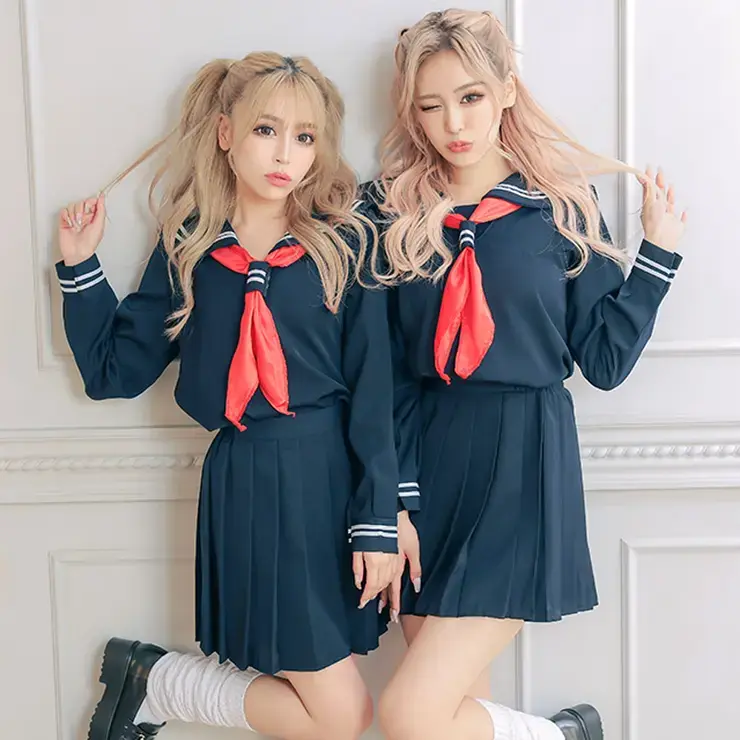Japanese School Uniforms
- Luisa Sugisawa
- Jan 16
- 4 min read

Introduction
Japanese school uniforms (seifuku, 制服) have become a global symbol of Japanese culture, largely thanks to their prominence in anime, manga, and films. Beyond their practical purpose, uniforms represent discipline, unity, and style. In this blog, we’ll dive into how these uniforms have evolved, their iconic status in pop culture, and the trends that made them unforgettable. From ルーズソックス (loose socks) to unique school bags and shoes, we’ll explore what makes these uniforms so fascinating—even beyond Japan.
The Iconic Styles of Japanese School Uniforms
1. Sailor Uniforms (Sērāfuku, セーラー服)
Traditionally worn by middle and high school girls, this style features a sailor collar, pleated skirts, and ribbon ties. Popularized in the early 1900s, the sailor uniform has become synonymous with youth and nostalgia.
In Anime: Sailor Moon made this style globally iconic, with its magical girl spin on traditional uniforms.
2. Gakuran (学ラン)
Worn by boys, the gakuran is a military-inspired jacket with a high collar and brass buttons. Often paired with black trousers and loafers, this uniform exudes formality.
In Anime: Think of characters like Josuke Higashikata from JoJo’s Bizarre Adventure or Takumi Fujiwara from Initial D.
3. Blazer Uniforms
Modern high schools often opt for blazers over sailor uniforms, paired with ties or bowties for a polished look.
In Anime: Blazer uniforms dominate in shows like Ouran High School Host Club and Fruits Basket, where their stylish designs stand out.
Trendy Accessories That Defined an Era
1. Loose Socks (Rūzu Sokkusu, ルーズソックス)
Popular in the 1990s and early 2000s, loose socks were a must-have for schoolgirls. These oversized socks, often worn scrunched around the ankles, became a rebellious fashion statement.
The Secret Glue: To keep their socks from sliding down, girls used a special adhesive called "sock glue" (sokkusu nori, ソックスノリ). This ingenious hack made the trend even more iconic.
Pop Culture: Loose socks are often seen in nostalgic anime or films set in the 90s, reflecting their cultural significance.
2. Eastboy and Other Popular Brands
During the height of school fashion trends, brands like Eastboy became staples for students. Known for their high-quality socks, sweaters, and scarves, Eastboy was a go-to for girls who wanted to personalize their uniforms while staying stylish.
Other brands like CONOMi and Kanko are popular today for customizable uniform pieces, including ties and skirts in various colors.
3. School Bags
While randoseru (ランドセル) are iconic for elementary school students, junior high and high school students typically use traditional backpacks or Boston bags (ボストンバッグ). These are often sleek, black or navy totes, sometimes adorned with small keychains or plushies.
In Anime: School bags are frequently featured in scenes where students head to or from school, often adding a personal touch to the character’s style.
4. Shoes
Standard school shoes are loafers, usually in black or brown, paired with plain or patterned socks. These shoes complete the uniform’s polished aesthetic while remaining practical for daily wear.
Customization: Students often express individuality through socks, like pastel patterns or branded options.
Japanese School Uniforms in Pop Culture
1. Anime’s Role in Popularizing Uniforms
School uniforms are not just clothing; they’re a storytelling tool in anime. From the romantic daydreams of characters passing notes in class to dramatic rooftop confrontations, uniforms evoke both nostalgia and relatability.
Examples:
Clannad: Showcases sentimental moments in sailor uniforms.
My Hero Academia: Features a modern blazer design that reflects the characters’ heroic ambitions.
2. International Appeal
Fans outside Japan often buy replica uniforms for cosplay or personal fashion. Online stores like Amazon and specialized shops sell anime-inspired uniforms, making it easy to embrace this iconic style.

The Modern Evolution of Uniforms
1. Gender Neutrality
Some schools are now offering gender-neutral uniforms, reflecting modern values and inclusivity. For example, students can choose between skirts, trousers, or blazers regardless of gender.
2. Casual Uniforms: Nanchatte Seifuku (何ちゃって制服)
These "fake" uniforms, inspired by traditional styles but designed for casual wear, are trendy among teenagers and young adults. Brands like Eastboy and CONOMi cater to this market.
3. Sustainability Trends
As eco-consciousness grows, some schools and brands are opting for sustainable materials in their uniforms, ensuring durability while reducing environmental impact.
Fun Facts and Trivia
Sock Glue: The special glue used for loose socks was so popular that it became a cultural phenomenon in itself. Brands like "Sock Touch" were a staple in schoolgirls’ bags.
Replica Uniforms: Some high-end replica uniforms sold for cosplay or fashion can cost over $300, reflecting their detailed craftsmanship.
Uniform Rules: Japanese schools are famously strict about uniforms, often specifying everything from skirt length to sock color.
Product Recommendations (paid links)
If you’re inspired to embrace the seifuku style, here are some fun options:
Replica Uniforms: Purchase anime-inspired uniforms from stores like Amazon or specialty cosplay shops. https://amzn.to/3DUhCtZ
Accessories: Find loose socks, sock glue, and school bags to complete your look. https://amzn.to/3CnnviF https://amzn.to/3E7Co9i.
Eastboy Items: Check out Eastboy’s modern takes on school fashion, from scarves to sweaters.
Conclusion
Japanese school uniforms are more than just clothing; they’re a cultural symbol, a nostalgic icon, and a fashion statement. From their evolution in pop culture to the unforgettable trends like rūzu sokkusu, these uniforms continue to fascinate fans worldwide. Whether you’re cosplaying, exploring Japanese culture, or just appreciating the aesthetic, school uniforms remain a timeless element of Japan’s identity.
Let us know your favorite anime featuring school uniforms or trends you’d love to see make a comeback!





Comments